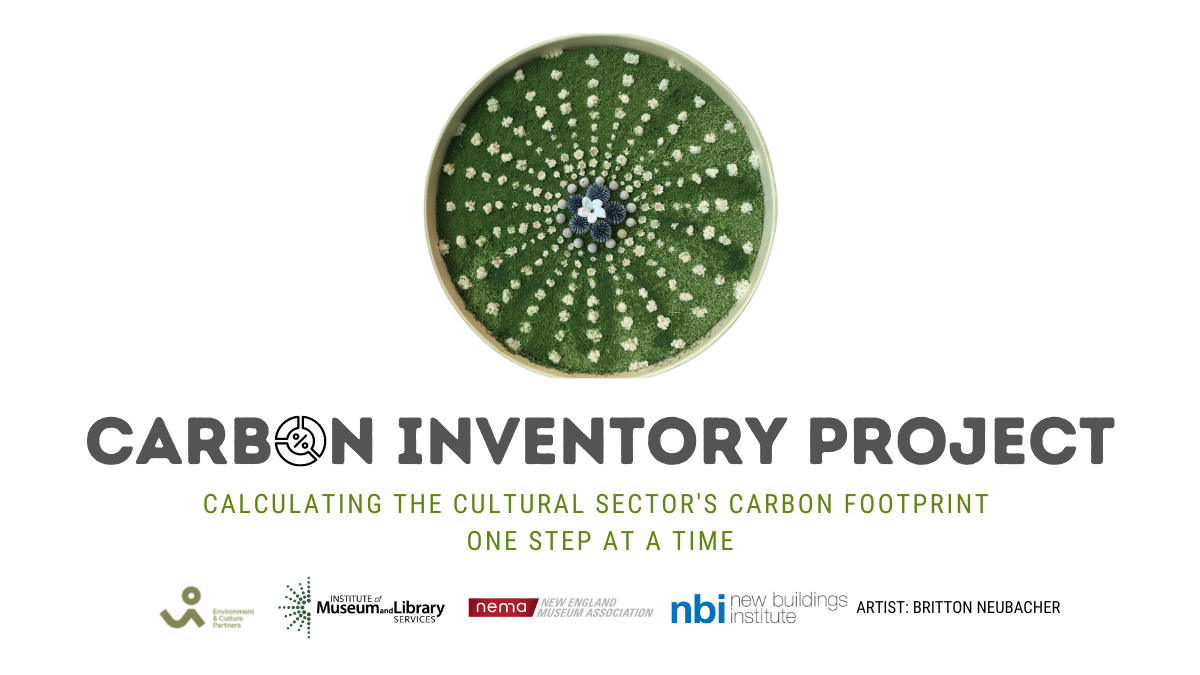
The energy use of buildings is one of the largest sources of carbon emissions worldwide, at an estimated 40 percent of total emissions, and cultural institutions are no exception. The buildings that house your museum, zoo, aquarium, garden, science center, or historic site use significant energy to light galleries, manage the environmental controls of collections, and to power shops, cafés, offices, and event spaces. With this energy use multiplied across an estimated thirty-five thousand museums in the US, you can imagine how great of a carbon impact our sector has. But beyond this general idea of the scale, we don’t know exactly what the number is. Fortunately, we are about to find out—if you’ll help.
The Carbon Inventory Project (CIP)—a joint initiative of the New England Museum Association, New Buildings Institute, and Environment & Culture Partners—is working to create the first US cultural sector carbon footprint and energy benchmark. Organizations like yours will submit their individual data, which will be anonymized into a single public number we will announce on the first annual Carbon Day, June 16, 2023. Museums that have already joined include the Exploratorium, Science Museum of Minnesota, Minnesota Marine Art Museum, Bernice Pauahi Bishop Museum, The Museum of Russian Icons, The Aldrich Contemporary Art Museum, Cincinnati Art Museum, SFMOMA, the Customs Museum, and Eau Claire Children’s Museum, just to name few.
Editor’s note: On June 16, 2023, the Carbon Inventory Project shared the final results of its inaugural study, based on data from eighty participating cultural institutions. Dig into detailed findings on our sector’s carbon use here, and find out how you can get involved in future efforts here.
With funding from an IMLS National Leadership Grant, CIP provides the resources necessary to help organizations learn how to measure, understand, and report their annual energy use. Whether you’re already collecting energy data, or this is new territory for you, we will help you along the way. Since the project began, CIP has been offering monthly presentations and office hours to support the success of its participants, which are all recorded so you can catch up if you want to join in.
Background
CIP is a result of the 2022 research study Culture Over Carbon (CoC), which sought to understand the impact of energy use in museums. Participants from more than 130 organizations across the spectrum of museum types submitted one year of energy-use data which the study analyzed for trends and opportunities. The official report will be released in summer 2023, but one notable finding was that the group’s total annual energy consumption was equivalent to 25 percent of the power produced at the Hoover Dam! Overall, the study indicated that the cultural sector stands to make a major impact by reducing energy-use carbon emissions in our buildings—but to do this, we’ll need to work together.
In recent years, more museums have started to respond to the need for climate leadership, examining the sustainability of their operations and leveraging their well-documented public trust to influence the public conversation. Museums across the nation are creating an increasing number of sustainability manager positions and sustainability strategic plans, as well as hosting educational programs and conference sessions about climate topics. There are even several sector-professional groups devoted to the issue.
But in addition to this simultaneous individual work, it’s important that we find ways to combine our efforts to maximize our impact. One of those is benchmarking the sector’s energy use through projects like CIP. Benchmarking energy use is the starting point from which we can compare, understand, and reduce our annual energy use and associated carbon emissions. Measuring and understanding energy use in our buildings is a high-return and low-risk effort for individual organizations, and sector-wide it has the potential for powerful collective climate action and environmental leadership. What might we learn about how we use energy? Are there simple things we can do to reduce it? What are the potential impacts on our communities who see us doing this work? What other behaviors might we start to change as a result?
You might be thinking, “This project sounds interesting, but my organization’s stakeholders or leadership team don’t have sustainability goals,” or, “My organization is too small for this extra work.” But even if you have these hesitations, there is good reason to participate anyway. This is a collective action for collective good, and it will also benefit your individual organization and community. Understanding how energy is used in your building may help you target opportunities to save money and create avenues for new funders and funding opportunities. One CoC participant, for instance, found an issue with a temperature sensor for one of its boilers, which helped them start saving energy—and money. Learning to report energy use now will also help prepare your organization for compliance with new or upcoming building codes and energy regulations, giving you a head start before it becomes a requirement. You may also find a sense of community among other organizations that are working towards sustainability. As another CoC participant put it, “No matter the size of the non-profit, all cultural orgs are in the same place—all struggling to tackle this and having shared experiences.” And equally important, while you’re doing this work, you’ll be modeling climate awareness, action, and resiliency for your community.







